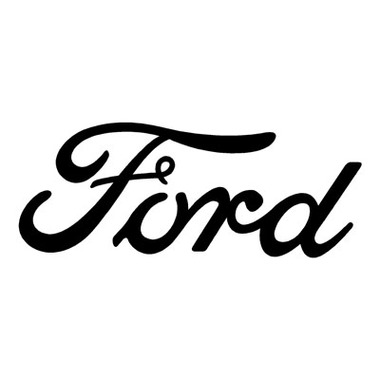 Ford Kuga Service ManualPaint - General Information » Corrosion Prevention
Ford Kuga Service ManualPaint - General Information » Corrosion Prevention
General
General
Although corrosion protection measures and painting processes in production have reached a very high technical standard and will be continuously developed further, in the long term corrosion on a vehicle cannot be totally avoided.
Further demands are therefore made of the paint specialist besides his knowledge of normal repainting of vehicles which have been repaired after an accident, in addition specialist knowledge is required for assessing and rectifying damage due to corrosion.
During repair painting, take care over the maintenance and re-creation of the corrosion protection applied in production, in view of the long-term warranty on Ford vehicles. Only those repair materials which are approved by Ford may be used for body repair work and repair painting.
For detailed information on corrosion protection measures during body repairs, please refer to chapter 501-25.
Furthermore, information on corrosion protection measures is repeated in individual chapters of the paint manual.
In particular, pay attention that the layer thicknesses specified in production are maintained.
The complete system of solid one-layer on galvanized steel panels must equal at least 90 |jm and the total system of two-layer on galvanized steel panels must equal at least 105 ^m.
It is important that sealing operations, as far as they are necessary, should be undertaken after the application of the paint to specification, in order to ensure the best corrosion protection. All components which form hollow cavities such as pillars, rails, side components etc. must be provided with a coating of cavity protection wax.
Causes of corrosion
Corrosion of steel is an electrochemical process during which the steel combines with oxygen. The following factors lead to corrosion:
- Acidic compounds contained in the air, such as carbonic acid and sulphur dioxide, combined with oxygen from the air and/or water. Salts such as sodium chloride used as road salt accelerate the corrosion process.
- Mechanical damage such as stone chips and scratches which penetrate through to the steel panel.
- Lack of care by the vehicle owner of the painted and corrosion proofed surfaces or areas on the vehicle.
- Unfavorable weather or environmental conditions, as may occur in areas with high humidity, high salt content in the air or serious air pollution due to aggressive gases and dusts.
In the case of mechanical damage, formation of rust can often be seen, beginning to spread into the painted surface from a point (stone chip) or from a line (scratch). If these faults are not professionally rectified in good time, the result is rusting through from the outside to the inside.
Rusting penetration from the inside to the outside occurs when for instance the cavity protection was inadequate.
General
Operations after painting
Definition of the degree of rust
Ford Kuga Service Manual
- General Information
- Jacking and Lifting
- Noise, Vibration and Harshness
- Suspension System - General Information
- Climate Control
- Auxiliary Climate Control
- Instrument Cluster and Panel Illumination
- Instrument Cluster
- Horn
- Warning Devices
- Parking Aid
- Charging System - General Information
- Battery, Mounting and Cables
- Generator and Regulator
- Voltage Converter/Inverter
- Information and Entertainment System - General Information
- Information and Entertainment System
- Exterior Lighting
- Interior Lighting
- Daytime Running Lamps (DRL)
- Module Communications Network
- Module Configuration
- Wiring Harnesses
- Anti-Theft - Active
- Anti-Theft - Passive
- Multifunction Electronic Modules
- Front End Body Panels
- Body Closures
- Interior Trim and Ornamentation
- Exterior Trim and Ornamentation
- Rear View Mirrors
- Seating
- Glass, Frames and Mechanisms
- Instrument Panel and Console
- Handles, Locks, Latches and Entry Systems
- Wipers and Washers
- Bumpers
- Safety Belt System
- Supplemental Restraint System
- Body Repairs - General Information
- Body Repairs - Vehicle Specific Information and Tolerance Checks
- Front End Sheet Metal Repairs
- Roof Sheet Metal Repairs
- Side Panel Sheet Metal Repairs
- Rear End Sheet Metal Repairs
- Paint - General Information
- Uni-Body, Subframe and Mounting System
- Suspension System - General Information
- Front Suspension
- Rear Suspension
- Wheels and Tires
- Driveshaft
- Rear Drive Axle/Differential
- Front Drive Halfshafts
- Rear Drive Halfshafts
- Brake System - General Information
- Front Disc Brake
- Rear Disc Brake
- Parking Brake and Actuation
- Hydraulic Brake Actuation
- Power Brake Actuation
- Anti-Lock Control
- Anti-Lock Control - Stability Assist
- Steering System - General Information
- Power Steering
- Steering Linkage
- Steering Column
- Steering Column Switches
- Engine System - General Information
- Engine- 2.5L Duratec (147kW/200PS) - VI5
- Engine Cooling
- Fuel Charging and Controls-2.5L Duratec (147kW/200PS) - VI5
- Fuel Charging and Controls - Turbocharger- 2.5L Duratec (147kW/200PS) - VI5
- Accessory Drive - 2.5L Duratec (147kW/200PS) - VI5
- Starting System- 2.5L Duratec (147kW/200PS) - VI5
- Engine Ignition - 2.5L Duratec (147kW/200PS) - VI5
- Engine Emission Control - 2.5L Duratec (147kW/200PS) - VI5
- Intake Air Distribution and Filtering - 2.5L Duratec (147kW/200PS) - VI5
- Evaporative Emissions
- Electronic Engine Controls
- Automatic Transmission/Transaxle
- Transmission/Transaxle Cooling
- Automatic Transmission/Transaxle External Controls
- Transfer Case
- Exhaust System-
- Fuel System
- Fuel Tank and Lines
- Acceleration Control
- Speed Control
- Climate Control System
- Climate Control
Main Categories
0.0175
